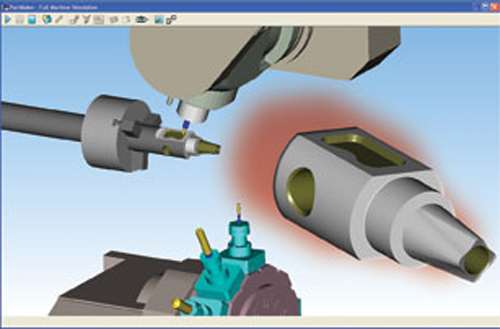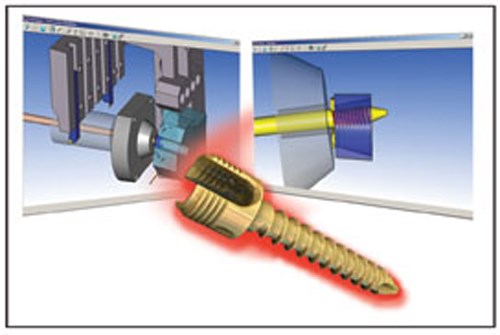Keeping Pace with CAM
The latest version of this CAM pacakge features 5-axis simultaneous machining for multi-axis lathes, improved milling functionality and enhanced thread whirling support.
During a time when many companies are struggling to determine where their next piece of the pie will come from, many suppliers are continuing to sink substantial investments into product development. This is significant because it shows their confidence in the market as they look forward to the continued interest in their products by customers who are looking to keep a hold on the market that sustains them.
PartMaker Inc., a division of Delcam Plc., has introduced its latest version of PartMaker software, Version 2010, for programming CNC mills, lathes, wire EDMs, turn-mill centers and Swiss-type lathes. Major highlights include the ability to perform five-axis simultaneous milling on multi-axis lathes, more powerful milling functionality and the ability to better visualize thread whirling.
Featured Content
“PartMaker Version 2010 provides the technology users will need to stay on the cutting edge of manufacturing and stay ahead of the competition by employing advanced milling strategies for today’s market,” says PartMaker President Hanan Fishman. The software provides the ability to program simultaneous five-axis milling operations on multi-axis lathes and more powerful 2 ½-axis milling functionality. These new milling capabilities, along with enhancements such as improved thread whirling visualization, will be especially beneficial to a large segment of users who are involved in the manufacture of medical devices.
While five-axis simultaneous milling is still new in the arena of Swiss-type lathes, multi-axis lathes with five-axis simultaneous milling capability are becoming more commonplace in small parts manufacturing. The software now positions users to take advantage of the growing complexity of milling on multitasking machines.
The five-axis simultaneous milling functionality is based on the technology already in place in PowerMILL, Delcam’s NC CAM software for the manufacture of complex shapes. Sharing in the technology pool of its parent company allows the PartMaker development team to deliver more advanced manufacturing technology to the marketplace faster.
Five-Axis Simultaneous Milling
An optional module allows simultaneous five-axis swarf milling on multi-axis lathes. Swarf machining is a technique that allows side cutting with an end mill while proceeding along the surface of a part, such as the sidewalls of a tapered rib. Swarf machining can be used for profiling the edge of components using the side of the tool to remove material. The benefits of five-axis simultaneous swarf machining over traditional three-axis milling strategies include significantly reduced machining time and improved surface finish. Employing swarfing can allow parts to be machined complete in a single setup by allowing for more advanced deburring techniques, thus eliminating time-consuming and laborious additional finishing. The new swarfing functionality in PartMaker lets users take advantage of B-axis lathes with five-axis simultaneous machining functionality.
Integration and Milling Strategies
For all complex five-axis machining strategies currently supported by PowerMILL (including blade and blisk machining), as well as for highly sophisticated three-axis strategies, Version 2010 features the option for a direct interface to PowerMILL. Tool paths can be imported directly into PartMaker, manipulated and synchronized on the Process Table, simulated and post processed directly from the working environment. This integrated solution assists users in part programming and optimization efficiency.
The software features a number of advanced 2 ½-axis milling routines not available in previous versions, including a variety of high speed machining strategies, trochoidal milling, rest area machining, face milling and a powerful pocketing strategy, among others. These additional milling strategies are also based on PowerMILL technology and have been adapted to work in an efficient and easy-to-use manner.
Thread Whirling
Also included with the software is an improved facility for automating the programming and simulation of thread whirling, a programming technique often used in the programming of “bone screw” threads as well as other specialty threads commonly found on threaded surgical implants. The popularity of thread whirling attachments on Swiss-type lathes has grown substantially in recent years because of the dual benefit this technique offers manufacturers making threaded parts. Specifically, thread whirling allows threaded products to be produced faster because this technique only requires a single pass, where as traditional threading routines require multiple passes to achieve the same result. Additionally, with the rigidity afforded by a sliding-headstock Swiss lathe, thread whirling can also provide higher and more repeatable precision.
Specially developed algorithms and user interface help to automate the programming of this unique manufacturing technique. And because these attachments can generally be quite large inside the working envelope of a machine, and thus increase the risk of collision during machining, the full 3D machining simulation allows verification of the process before a part is run.
Additional Productivity Enhancements
PartMaker Version 2010 includes a number of user requested productivity enhancements. Among these improvements are enhanced grooving functionality, powerful and flexible threading capability, improved solids-based programming and additional CAD functionality. Additionally, 2D toolpath selection has been improved from previous versions. The new automated toolpath selection techniques provide users a significant productivity improvement by measurably speeding up programming time. Space ball support has also been added for simpler on-screen manipulation of 3D models.
RELATED CONTENT
-
Precision Machining Eastec Technology Preview September 2021
Production Machining highlights some of the latest precision machining advances and technology updates that will be showcased at Eastec 2021, Oct. 19-21 in West Springfield, Massachusetts.
-
Winning New Jobs With Online Bidding
The digital revolution is hitting the business of the multiple-spindle automatic machining--in two distinct forms, no less. Twenty-five years after the first wave of digitization in manufacturing (numerical control) its linear descendant, computer numerical control or CNC, is changing the way screw machine shops do business.
-
Adding 5-Axis Capability to a 3-Axis CNC Mill
This attachment provides shops using thee-axis machining centers the option of on-demand four- and five-axis machining.








